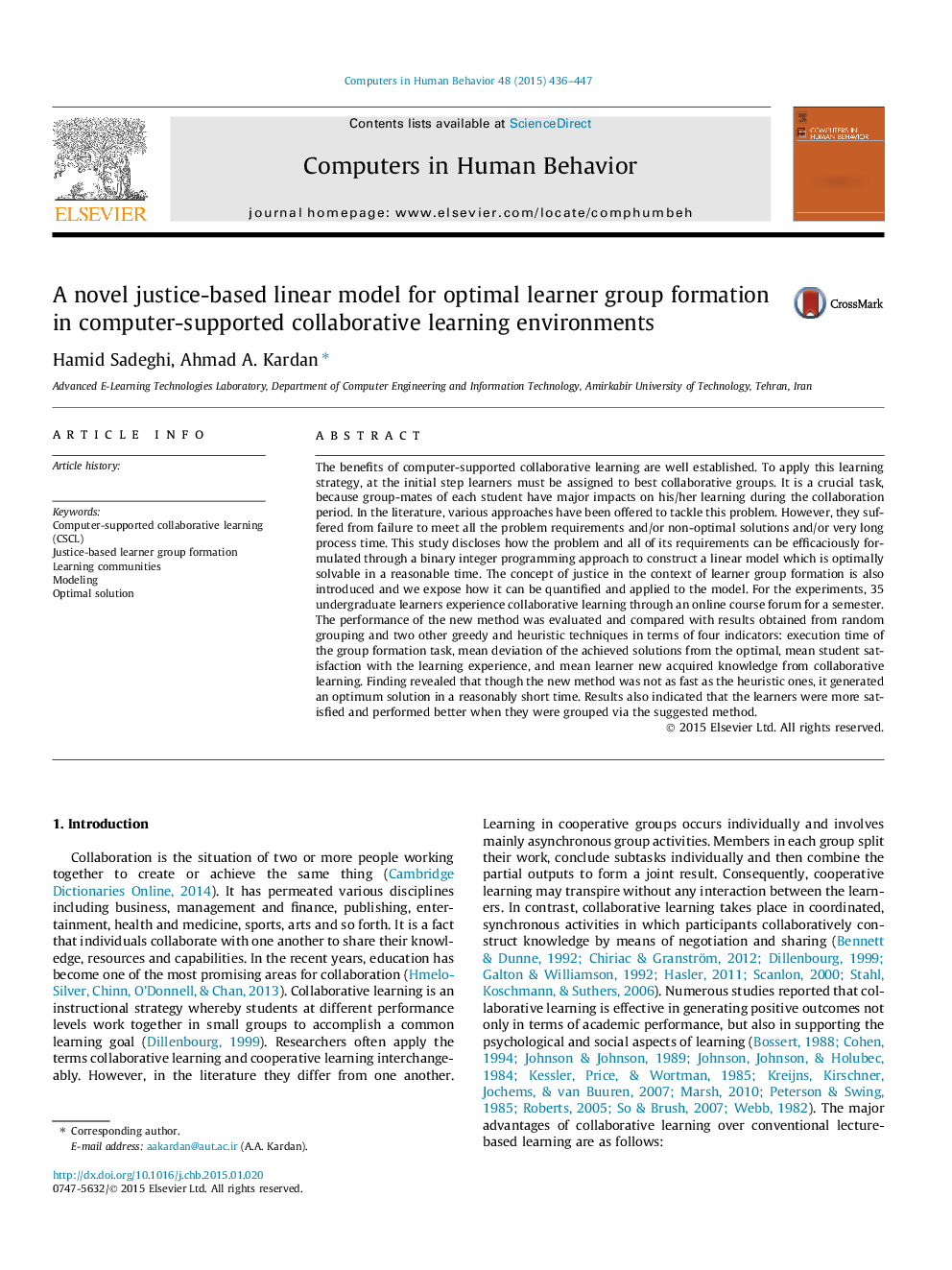| کد مقاله | کد نشریه | سال انتشار | مقاله انگلیسی | نسخه تمام متن |
|---|---|---|---|---|
| 6838397 | 618437 | 2015 | 12 صفحه PDF | دانلود رایگان |
عنوان انگلیسی مقاله ISI
A novel justice-based linear model for optimal learner group formation in computer-supported collaborative learning environments
ترجمه فارسی عنوان
یک مدل خطی مبتنی بر عدالت برای تشکیل گروه های یادگیرنده بهینه در محیط های یادگیری همکاری کامپیوتری
دانلود مقاله + سفارش ترجمه
دانلود مقاله ISI انگلیسی
رایگان برای ایرانیان
کلمات کلیدی
ترجمه چکیده
مزایای یادگیری مشارکتی رایانه ای به خوبی شناخته شده است. برای اعمال این استراتژی یادگیری، در مرحله اول، فراگیران باید به بهترین گروه های همکاری اختصاص داده شوند. این کار بسیار مهم است، زیرا گروهی از دانش آموزان در طول دوره همکاری تاثیرات عمده ای بر یادگیری او دارند. در ادبیات، رویکردهای مختلفی برای مقابله با این مشکل ارائه شده است. با این حال، آنها از ناتوانی در برآورده کردن تمام نیازهای مشکوک و / یا راه حل های غیر مطلوب و / یا زمان بسیار طولانی مدت رنج می بردند. این مطالعه نشان می دهد که چگونه مشکل و تمام الزامات آن را می توان با استفاده از یک رویکرد برنامه ریزی عدد صحیح باینری به منظور ساخت یک مدل خطی که به طور مطلوب قابل حل در یک زمان معقول است، می توان فرموله کرد. مفهوم عدالت در زمینه شکل گیری گروه یادگیرنده نیز معرفی شده است و ما نشان می دهیم چگونه می توان آن را به صورت کوانتومی و به مدل اعمال کرد. برای آزمایشی، 35 دانشجوی دوره کارشناسی، یک دوره آموزشی آنلاین را برای یک ترم تجربه می کنند. عملکرد روش جدید ارزیابی و مقایسه شده با نتایج حاصل از گروه تصادفی و دو روش دیگر حریصانه و اکتشافی در چهار شاخص: زمان اجرای کار تشکیل گروه، انحراف میانگین راه حل های به دست آمده از رضایت دانشجویان مطلوب و متوسط با تجربه یادگیری، و به معنی یادگیری دانش جدید به دست آمده از یادگیری مشارکتی است. پیدا کردن نشان داد که با وجودی که روش جدید به همان اندازه سریعتر از اکتشاف است، راه حلی بهینه در یک زمان نسبتا کوتاه ایجاد شده است. نتایج همچنین نشان داد که از طریق روش پیشنهاد شده، فراگیران بیشتر راضی هستند و بهتر عمل می کنند.
موضوعات مرتبط
مهندسی و علوم پایه
مهندسی کامپیوتر
نرم افزارهای علوم کامپیوتر
چکیده انگلیسی
The benefits of computer-supported collaborative learning are well established. To apply this learning strategy, at the initial step learners must be assigned to best collaborative groups. It is a crucial task, because group-mates of each student have major impacts on his/her learning during the collaboration period. In the literature, various approaches have been offered to tackle this problem. However, they suffered from failure to meet all the problem requirements and/or non-optimal solutions and/or very long process time. This study discloses how the problem and all of its requirements can be efficaciously formulated through a binary integer programming approach to construct a linear model which is optimally solvable in a reasonable time. The concept of justice in the context of learner group formation is also introduced and we expose how it can be quantified and applied to the model. For the experiments, 35 undergraduate learners experience collaborative learning through an online course forum for a semester. The performance of the new method was evaluated and compared with results obtained from random grouping and two other greedy and heuristic techniques in terms of four indicators: execution time of the group formation task, mean deviation of the achieved solutions from the optimal, mean student satisfaction with the learning experience, and mean learner new acquired knowledge from collaborative learning. Finding revealed that though the new method was not as fast as the heuristic ones, it generated an optimum solution in a reasonably short time. Results also indicated that the learners were more satisfied and performed better when they were grouped via the suggested method.
ناشر
Database: Elsevier - ScienceDirect (ساینس دایرکت)
Journal: Computers in Human Behavior - Volume 48, July 2015, Pages 436-447
Journal: Computers in Human Behavior - Volume 48, July 2015, Pages 436-447
نویسندگان
Hamid Sadeghi, Ahmad A. Kardan,
